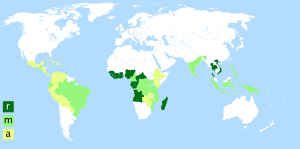Robusta coffee
| Robusta coffee | ||||||||||||
|---|---|---|---|---|---|---|---|---|---|---|---|---|

Robusta coffee ( Coffea canephora ) |
||||||||||||
| Systematics | ||||||||||||
|
||||||||||||
| Scientific name | ||||||||||||
| Coffea canephora | ||||||||||||
| Pierre ex A. Froehner |
The Robusta coffee or lowland coffee (scientific. Coffea canephora ) is a plant from the genus coffee ( Coffea ). It was discovered in Africa in the 19th century .
features
Robusta coffee grows as a shrub or a tree up to eight meters high. In culture, the plants are kept significantly smaller for better manageability. The leaves are oblong-elliptical, rarely egg or lanceolate. They are up to 40 centimeters long, have a clear point and sometimes a slightly wavy edge. The stipules are triangular and pointed with a length of six to 18 millimeters. The flowers are five to six, rarely seven and are in axillary clusters of eight to thirty. The fruits are broad, ovoid-elliptical and usually contain two seeds, the so-called coffee beans . These are yellow-brown, round and have a straight notch on the flat side.
The number of chromosomes is 2n = 22.
Cultivation
Since Robusta coffee is sensitive to the cold, cultivation is limited to the 10th parallel (south and north) of the equator. Southeast Asia and West Africa therefore offer good climatic conditions.
Robusta is mainly grown in the lowlands, ideally below 700 meters altitude.
As of 2015, Vietnam is the largest producer and exporter of Robusta.
use
With around 40% of the world's coffee harvest, Robusta is the second most important type after Arabica coffee . This type is less sensitive to diseases, heat and high humidity. It bears more fruits that ripen faster. The ripening period is about 6 months, which means that several harvests per year are possible.
The fruits are usually processed dry. They are dried in the sun as a whole with pulp and parchment wrapping and then processed in peeling machines, which extract the actual beans.
The taste of Robusta is earthy to woody. Robusta is more bitter and has fewer aromas than Arabica, but it has a fuller body, which is why it is particularly valued for espresso . At two to four percent, the caffeine content is around twice as high as in Arabica coffee and the chlorogenic acid content is also around twice as high. High-quality coffee blends mostly consist of Arabica, but Robusta is often added to Arabica, especially in espresso blends (e.g. in a ratio of 20:80) in order to achieve a higher caffeine content and a more intense aroma.
Individual evidence
- ↑ Cultivated Rubiaceae. Retrieved March 13, 2013 .
- ^ Coffea canephora at Tropicos.org. In: IPCN Chromosome Reports . Missouri Botanical Garden, St. Louis
- ^ Brewed awakening. Retrieved January 27, 2018 .
- ↑ Jose Luis Penarredonda: The disease That Could change how we drink coffee. Retrieved January 27, 2018 .
- ^ Coffea canephora. (No longer available online.) In: Caffè Barone. Archived from the original on April 2, 2015 ; Retrieved March 13, 2013 . Info: The archive link was inserted automatically and has not yet been checked. Please check the original and archive link according to the instructions and then remove this notice.
literature
- Dirk Selmar, Gerhard Bytof: Biochemical basics of post-harvest treatment: The secret of a good coffee . In: Biology in Our Time . tape 38 , 2008, p. 158-167 .

